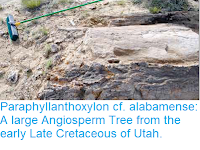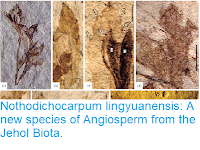The Core Dicots are the single largest grouping of Flowering Plants, Angiosperms, and include groups such as the Saxifrages, Vines, Beaches, Oaks, Roses, Gourds, Willows, Geraniums, Myrtles, Cabbages, Citruses,Horse Chestnuts, Mangoes, Cacti, Heathers, Sunflowers, Honeysuckles, Nightshades, Olives, and Lavenders. The oldest fossils currently assigned to the group come from the Late Cretaceous of North America, though molecular clock dating methods suggest that the group is likely to be considerably older.
In a paper published in the journal Scientific Reports on 13 November 2018, Zhong-Jian Liu of the Key Laboratory of National Forestry and Grassland Administration for Orchid Conservation and Utilization at Fujian Agriculture and Forestry University, Diying Huang and Chenyang Cai of the State Key Laboratory of Palaeobiology and Stratigraphy at the Nanjing Institute of Geology and Palaeontology and Center for Excellence in Life and Paleoenvironment of the Chinese Academy of Sciences, and Xin Wang of the Key Laboratory of Economic Stratigraphy and Paleogeography at the at the Nanjing Institute of Geology and Palaeontology and Center for
Excellence in Life and Paleoenvironment of the Chinese Academy of
Sciences, describe a new Core Dicot flower from Middle Cretaceous Burmese Amber.
Cretaceous ‘Burmese Amber’ has been extensively worked at several sites
across northern Myanmar (though mostly in Kachin State) in the last 20
years. The amber is fairly clear, and often found in large chunks,
providing an exceptional window into the Middle Cretaceous Insect fauna.
This amber is thought to have started out as the resin of a Coniferous
Tree, possibly a Cypress or an Araucaria, growing in a moist tropical
forest. This amber has been dated to between 105 and 95 million years
old, based upon pollen inclusions, and to about 98.8 million years by
uranium/lead dating of ash inclusions in the amber.
The new flower is named Lijinganthus revoluta, where 'Lijinganthus' means 'Li Jing's flower', in honour of Li Jing (1967–2015) for her talent and poetry, and 'revoluta' refers to the petals of the flower, which are revolute (are rolled back at the edges). The flower is 6.5 mm in length and 4.8 mm in width, with five petals and five sepals, a pedicel, stamens, and a gynoecium.
Lijinganthus revoluta embedded in a Myanmar amber. (a) Side view of the flower, showing physically connected pedicel (white triangle), petals (1–5), and stamens. Scale bar is 1 mm. (b) Top view of the flower, showing petals (1–5), anthers (white triangles), and ovary (double triangle). Note the relationship between stamens (a,b) and Petal 4. Scale bar is 1 mm. (c) Bottom view of the flower, showing revolute petals (1–5) and stamens. Scale bar is 1 mm. (d) Detailed view of the rectangular region in 1c, showing the relationship among sepal (white line), petal (4), and 2 filaments (white triangles). Scale bar is 0.1 mm. Liu et al. (2018).
See also...
Follow Sciency Thoughts on Facebook.






